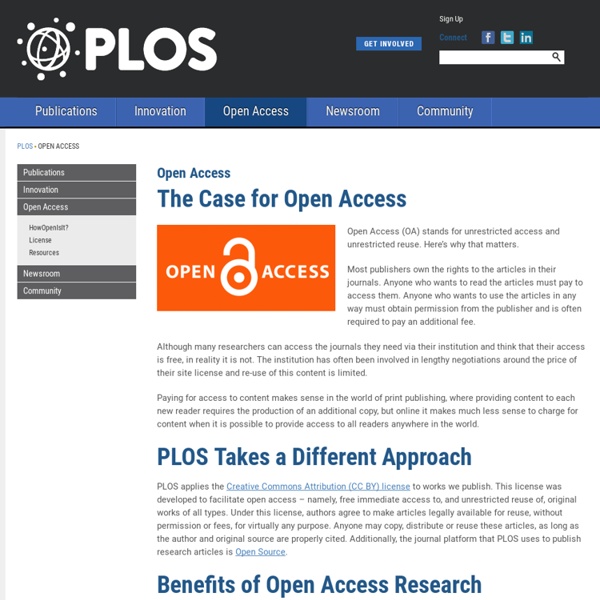PLoS Biology : Publishing science, accelerating research
A Peer-Reviewed, Open Access Journal Current Issue PLOS Biology is a peer-reviewed, open-access journal featuring research articles of exceptional significance in all areas of biological science, from molecules to ecosystems.
A few Religious Studies articles showing up in SAGE Open open access “mega journal”; reviewers being solicited « Omega Alpha
The other day I received an email from a librarian colleague who is also a scholar in New Testament. He considers himself an “under-employed Ph.D.,” by which I gather means having the academic credentials but not a full teaching position. I don’t know the circumstances of his situation, but I do know he is not alone.
Oxford Open
Oxford Open OUP Supports Open Access Oxford University Press (OUP) is mission-driven to facilitate the widest possible dissemination of high-quality research. We embrace both green and gold open access (OA) publishing to support this mission. A Proven Track Record of Success
Current Therapeutic Research - Moving to Gold Open Access Model from January 2013
Current Therapeutic Research - Change to Gold Open Access Model >> Submit your paper Current Therapeutic Research serves an international audience of scientists and clinicians in a variety of research, academic and clinical practice settings by quickly disseminating research findings.The journal provides a home for the rapid publication of:
Accelerating Future
There isn’t enough in the world. Not enough wealth to go around, not enough space in cities, not enough medicine, not enough intelligence or wisdom. Not enough genuine fun or excitement. Not enough knowledge.
Moodle
In our quest to enable you to download medical books for free in pdf format, we have decided to compile a decent list of several free medical books download websites where you can get free life science and medical books for free. Our list is comprehensive and it includes all the info on where to download free life science and medical books for free in pdf or epub. So if you can’t find the book you need on our website, we have compiled a list of free medical books pdf download sites, where you can get any biological science or medical book for free. We have to compile this list so you can access free ebook download pdf from reputable free medical book download sites that either allow you to get free medical ebooks on rent, on sale or and also download any book for free pdf.
Journal of Neuropsychiatric Disease and Treatment - Dove Press
Neuropsychiatric Disease and Treatment Open access peer-reviewed scientific and medical journals. Open Access Dove Medical Press is now a member of the Open Access Initiative A guide to help authors get their paper published. Support Open Access and Dove Press Promotional Article Monitoring - further details Real benefits for authors, including fast-track processing of papers. (4,820,110) Views ISSN 1178-2021 (Online) An international, peer-reviewed journal of clinical therapeutics and pharmacology focusing on concise rapid reporting of clinical or pre-clinical studies on a range of neuropsychiatric and neurological disorders.
Science and technology research news
« Prev | 1 | 2 | 3 | 4 | 5 | 6 | 7 | 8 | 9 | 10 | Next » Detecting corrosion and fatigue during service A new project, CORFAT (Cost effective corrosion and fatigue monitoring for transport products SCP7-GA-2008-218637), looks to develop new monitoring technology based on acoustic emission testing (AT) combined with follow-up NDT (non-destructive testing) to detect defects such as corrosion or cracks in the structure of surface transport products (ships, railway tank cars, road tankers). Projects talks to Andreas Jagenbrein about predictive maintenance and what this means for transport safety.



